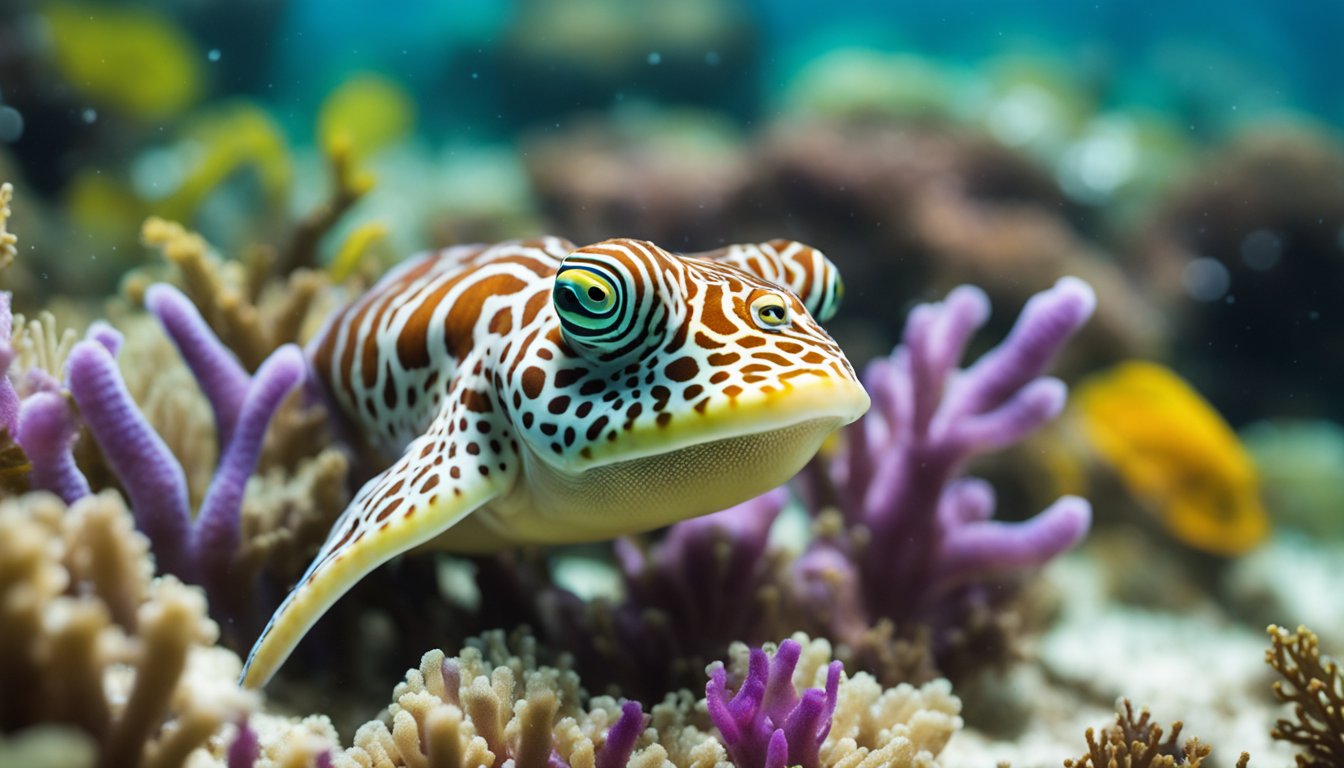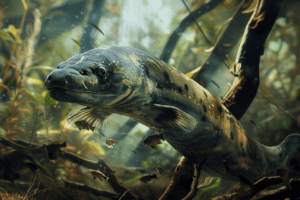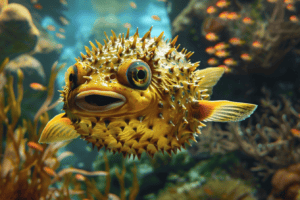Cuttlefish are some of the most fascinating creatures in the ocean.
These intelligent cephalopods are known for their incredible ability to change color and texture, allowing them to blend seamlessly into their surroundings.
But cuttlefish are more than just masters of disguise.
They are also skilled hunters, using their camouflage to sneak up on prey and their sharp beaks to capture and devour their meals.

One of the most remarkable things about cuttlefish is the way they change color.
Unlike other animals that use pigments to create color, cuttlefish have specialized cells called chromatophores that allow them to rapidly change the color and texture of their skin.
This means they can blend in with their environment, communicate with other cuttlefish, and even hypnotize their prey.
Despite their small size, cuttlefish are formidable hunters. They have excellent eyesight and can detect the slightest movements of their prey.
They also have a unique hunting strategy that involves using their camouflage to sneak up on their target and then using their powerful beaks to grab and crush their prey.
With their incredible abilities, it’s no wonder that cuttlefish are often referred to as the “ocean’s chameleons.”
Unveiling the Cuttlefish

Cuttlefish are the ocean’s chameleons, masters of disguise that can change their skin color, texture, and patterns to blend in with their surroundings.
These fascinating creatures belong to the mollusk family and are closely related to squids and octopuses.
In this section, we will explore the anatomy, habitats, and species of these incredible animals.
Anatomy of Deception
Cuttlefish have a unique anatomy that allows them to change their appearance rapidly.
They have a soft, elongated body with eight arms and two tentacles that they use for hunting and defense.
Their skin is covered in chromatophores, specialized pigment cells that can expand or contract to change color.
Cuttlefish can also alter the texture of their skin by contracting muscles called papillae, which create bumps and ridges.
Their eyes are among the most advanced in the animal kingdom, with a W-shaped pupil that allows them to see in both directions simultaneously.
They can also change the shape of their pupils to adjust their focus and depth perception.
Cuttlefish have a highly developed brain and are known for their intelligence, problem-solving abilities, and complex communication skills.
Habitats and Species
Cuttlefish can be found in oceans all over the world, from shallow coral reefs to deep sea trenches.
They prefer warm, tropical waters with plenty of hiding places and prey.
There are over 120 species of cuttlefish, ranging in size from a few centimeters to over a meter in length.
Some of the most common species include the flamboyant cuttlefish, which has bright, bold colors and a unique swimming style; the giant cuttlefish, which can weigh up to 10 kilograms and change color to communicate with other cuttlefish; and the common cuttlefish, which is known for its ability to blend in with its surroundings and ambush prey.
Cuttlefish are an important part of the ocean ecosystem, serving as both predator and prey.
They feed on small fish, crustaceans, and other invertebrates, while larger predators such as sharks and dolphins hunt them for food.
Despite their importance, cuttlefish populations are threatened by overfishing, habitat destruction, and climate change.
In conclusion, cuttlefish are fascinating creatures with unique abilities that allow them to survive in a variety of habitats.
Their anatomy and behavior have captured the attention of scientists and nature enthusiasts alike, and there is still much to learn about these masters of disguise.
Masters of Camouflage
Cuttlefish are the true masters of camouflage, able to change their skin color and texture in a split second to blend into their surroundings.
They use this remarkable ability for many purposes, from hiding from predators to attracting mates.
Color-Changing Wonders
Cuttlefish have specialized cells called chromatophores that contain pigments and can expand or contract to change the color of their skin.
By adjusting the size and shape of these cells, cuttlefish can create a wide range of colors and patterns, from bright blues and greens to muted browns and grays.
But color-changing is just the beginning. Cuttlefish can also change the texture of their skin to match their surroundings.
They do this by controlling tiny muscles called papillae that raise and lower bumps on their skin.
By mimicking the texture of rocks, coral, or seaweed, cuttlefish can disappear into their environment.
The Science of Invisibility
How do cuttlefish know what color and texture to change their skin to? It turns out they have an incredible sense of sight.
Cuttlefish have eyes that are similar to human eyes, but they can see polarized light, which helps them detect the angle of the sun and the direction of the light source.
They also have excellent depth perception, which allows them to judge distances accurately.
But that’s not all. Cuttlefish also have a special organ called the statocyst that helps them sense their orientation in the water.
This organ contains tiny grains of calcium that move in response to gravity, giving the cuttlefish a sense of up and down.
By combining all of these senses, cuttlefish can create a perfect disguise that fools even the most observant predator.
In conclusion, cuttlefish are truly amazing creatures that have evolved some of the most advanced camouflage abilities in the animal kingdom.
By changing their skin color and texture, they can blend into their surroundings and disappear from view.
Their remarkable sense of sight and orientation helps them create a perfect disguise, making them the ocean’s chameleons.
Beyond Camouflage

Cuttlefish are not only masters of disguise, but they also have impressive communication and hunting techniques that are worth exploring.
Communication and Courtship
Cuttlefish are highly social creatures that use a variety of signals to communicate with each other.
They can change the color and texture of their skin to signal aggression, submission, or courtship.
They also use their tentacles to convey messages through touch.
During courtship, male cuttlefish perform elaborate displays to attract females.
They change the color and pattern of their skin, and sometimes even create 3D shapes to impress their potential mates.
This process is called “biochromatic” or “bio-luminescent” communication, and it is a fascinating example of the complexity of animal behavior.
Hunting Techniques
Cuttlefish are also skilled hunters that use a variety of techniques to capture their prey.
They can change the color and texture of their skin to blend in with their surroundings, making them nearly invisible to their prey.
They also use their tentacles to capture and immobilize their victims.
One of their most impressive hunting techniques is their ability to create visual illusions.
They can manipulate the polarization of light to create patterns that confuse their prey and make them easier to catch.
This technique is similar to the way a magician uses misdirection to fool their audience.
In conclusion, cuttlefish are not only masters of disguise but also skilled communicators and hunters.
Their abilities are a testament to the complexity and diversity of the natural world, and they continue to fascinate scientists and nature enthusiasts alike.
Frequently Asked Questions

How do cuttlefish change their color and texture?
Cuttlefish have a unique ability to change their color and texture to blend in with their surroundings.
They have specialized skin cells called chromatophores that contain pigments which they can expand or contract to change their color.
Additionally, they can also change the texture of their skin by controlling small muscles that raise or lower bumps called papillae.
By changing their color and texture, cuttlefish can mimic their environment and become almost invisible to predators or prey.
What are some of the unique abilities that make cuttlefish effective at camouflage?
Cuttlefish have several unique abilities that make them masters of disguise.
In addition to their chromatophores and papillae, they can also change the shape of their body to match their surroundings.
They have large, W-shaped pupils that allow them to see polarized light, which helps them detect patterns and colors in their environment.
Cuttlefish can also rapidly adjust their camouflage to match changing backgrounds, making them highly effective at hiding from predators or sneaking up on prey.
In what ways do cuttlefish use their camouflage in the wild?
Cuttlefish use their camouflage to blend in with their surroundings and avoid detection by predators or prey.
They can mimic the color and texture of rocks, sand, seaweed, and even other animals.
They can also use their camouflage to communicate with other cuttlefish, displaying different patterns and colors to signal aggression, submission, or mating readiness.
What are the differences between cuttlefish and other cephalopods regarding disguise?
While all cephalopods have some ability to camouflage themselves, cuttlefish are particularly adept at it.
Unlike octopuses, which can only change their color, cuttlefish can also change their texture and shape.
Squid have similar abilities to cuttlefish, but they tend to use their camouflage more for quick escapes than for long-term hiding.
Can cuttlefish control their camouflage, or is it an automatic response?
Cuttlefish can control their camouflage consciously, using their eyes and brain to adjust their color, texture, and shape.
However, they can also use their camouflage as an automatic response to external stimuli, such as sudden movements or changes in light.
This allows them to quickly adapt to new situations and avoid detection by predators or prey.
How does cuttlefish camouflage contribute to their survival in the ocean?
Cuttlefish camouflage is a crucial survival mechanism that allows them to avoid predators and capture prey.
By blending in with their surroundings, they can stay hidden and avoid detection, increasing their chances of survival.
Cuttlefish camouflage also allows them to communicate with other cuttlefish and attract mates, ensuring the survival of their species.
Overall, cuttlefish camouflage is an amazing adaptation that helps them thrive in the complex and ever-changing environment of the ocean.









